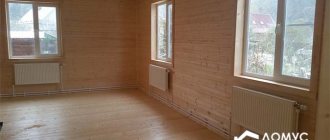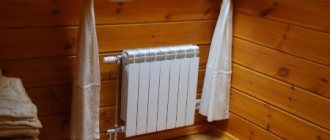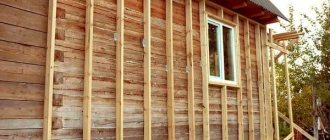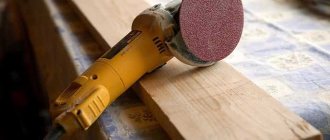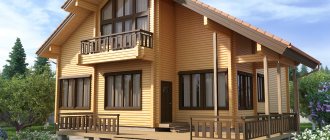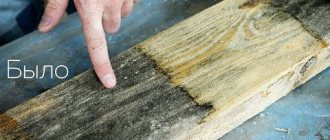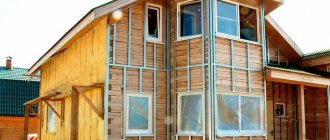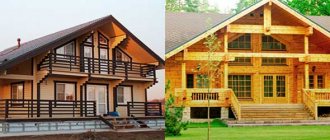This article is devoted to common methods of heating housing made of timber. Even at the stage of development and construction of a new house, it is necessary to decide on the future heating system, because despite the fact that timber buildings preserve the internal microclimate quite well, the heating system should not be neglected. In most of the Russian Federation, in winter the temperature can drop to -40. Let's consider what modern heating of a house made of timber can be like.
- Stove heating
- Steam heating in a wooden house
- Air heating
- Water underfloor heating
- Electric underfloor heating
Vodyanoye
The classic solution in log houses is radiators, in which liquid heated to 40-95 ℃ (water, antifreeze, antifreeze) circulates.
The coolant liquid moves in a closed loop through pipes from the boiler (gas, electric, solid fuel) to the radiators and back. There are two ways to circulate fluid:
- Forced. An electric circulation pump provides the required pressure in the pipes.
- Natural. It works due to the physical laws of gravity and hydrostatic pressure (i.e., the difference in height, as well as the difference in the density of the heated and cooled coolant).
Peculiarities
Forced circulation:
- Suitable for any heating area.
- Depends on power supply.
- More difficult to install.
Natural circulation:
- Does not depend on power supply.
- Used in small houses up to 50-100 m2.
Stove heating in a wooden house
Since ancient times, people have used stoves to heat their homes. This heating method is designed to heat the room in which the heat source itself is located. The undoubted advantage of stoves is that for their operation, you can use different types of fuel , which is why they have been popular in many countries of the world for many centuries.
However, many are mistaken in thinking that with just one stove they can heat the entire building. This principle applies only to small buildings. It is necessary to take into account the power of the stove and correlate it with the heated area. Therefore, such heating is suitable only for one-story houses and small buildings with an attic.
Let's look at the disadvantages of stoves
- Low efficiency, not economical
- You have to constantly add fuel
- Do not use high-calorie coal
- With periodic (non-constant) heating throughout the day, the temperature can change dramatically;
- Stove installations and fireplaces take up a significant area that could be used for other useful purposes;
- Constant presence of contamination due to the fuel used;
- Increased risk of fire
For large buildings, the stove can be used as heating source The best solution for such buildings is steam heating.
Electrical
The most common electric heating systems are with electric convectors. Electric convector radiators are equipped with various heating elements - open filaments, heating elements, nichrome spirals.
- Models with filaments are cheap, but require good ventilation. Dust falls on the threads and burns, hence the unpleasant odors.
- A heating element (thread in a tube) is the safest option.
- Nichrome coils are chemically inert, durable, and highly efficient.
Modern electric radiators have a built-in programmer - a programmable thermostat. You can set a timer and set the desired temperature. And even set up work on specific days of the week, so as not to heat an empty house and warm the rooms before the owners arrive.
Peculiarities
- Mobile compact equipment.
- Comfortable use.
- Electricity costs.
- Energy dependence.
Air heating of a house made of timber
In this case, air itself is used as a coolant. After heating, it is supplied to the heated room through special air ducts. Such systems are widespread in Western European countries with a temperate continental climate and mild winters.
The heated air is generated here in an air heater. The operating principle of a heat source is based on the combustion of fuel in the form of liquid or gas in a special chamber. Cold air flows, using a special fan, enter the exchanger where they are heated. Additionally, before heating, they can be cleaned of dust and enriched with oxygen. Next, the heated air enters the room through special air ducts.
Advantages of the air system
- High efficiency;
- Lack of additional components, in the form of pipes, hoses, for transferring coolant
- Possibility of connecting additional climate control equipment, with which you can maintain an optimal microclimate;
- Easy control and switching to different temperatures;
- No condensation on windows;
- Great for heating large areas.
Flaws
The negative aspects of such heating include:
- The need for installation during construction of the building. Therefore, when designing, you should immediately take this into account, since air ducts are installed in special niches in the walls, mounted under a suspended ceiling or in false walls.
- In addition, this heating method must be constantly maintained, and making changes to an existing wiring is quite difficult.
Warm floor
The "warm floor" system can be water or electric. In the first case, the coolant moves in a closed loop - in tubes laid under the hearth screed. In the second, the tubes are replaced with electric heating cables.
Peculiarities
- Complicated installation.
- Expensive repairs (you have to remove the floors to the base).
- Does not affect the design of the room, but slightly reduces its height.
- Heats the entire area of the room evenly.
- There are no drafts or dry air.
- Convenient controls.
- Electricity costs (for underfloor heating with electric heating).
Steam heating in a log house
The principle of steam heating is the circulation of hot water through a closed system consisting of a boiler, expansion tank and polypropylene pipes. From the physics course we know that hot water has a lower specific gravity, due to this, it rises through the pipes. As the system passes through, it cools, becomes heavier and moves downward. To improve circulation, it is recommended to install a circulation pump into the system. As a coolant, it is better to use a special non-freezing liquid. If the heating system freezes, in various emergency situations, nothing will happen to the pipes. If you use ordinary water, it can turn into ice and damage the system.
Advantages of steam heating
- With its help, you can heat almost any home in size.
- The boiler is located in a separate room. There is no soot and dirt in the house
- Ability to adjust temperature
- The efficiency of many boilers is quite high, more economical use
- You can use solid fuel with high efficiency, such as coal
- Some boiler models can be switched to gas or you can choose an electric boiler, although it is not economical
- Possibility to choose a double-circuit boiler for heating and hot water supply
- One bookmark is enough for 16-20 hours
Flaws
- Difficult and expensive installation
- Expensive boilers, maintenance required
- Boiler room required
- Dependence on electricity. Without electricity, the circulation pump will not work.
In addition, do not forget that the heat from steam heating can negatively affect the wood from which the home is built. If the room is heated irregularly, the water in the components may freeze. If any problems arise, it is not always possible to fix them promptly
What characteristics should you look for when choosing?
The purpose of heating devices is to transfer heat and distribute it evenly throughout the living rooms, creating a comfortable temperature in the cold season - at least 20–22 °C.
Article on the topic: How to make a fence from a picket fence
It is difficult for a beginner to navigate the variety of radiators on the market for heating private homes. Sometimes an ignorant person pays attention only to appearance and cost . This is a misconception that can cost you dearly.
Experts recommend being guided primarily by the technical characteristics of the elements of the autonomous heat supply system. You can familiarize yourself with them in the product passport or seek the help of a sales consultant.
Attention! To determine the power of heating devices, take into account the heat loss of living rooms. They must correspond to the heat loss of the building per unit of time (one hour) , depending on the wall material, outside temperature, and climate zone.
Underfloor heating system in a wooden house
At the moment, there are two options for underfloor heating:
- Using water
- Electrically heated
Positive aspects of underfloor heating
- The room warms up evenly, to approximately +26, up to a height of 1.5 m
- Heating a log house with warm floors prevents drafts.
- The air in the rooms does not dry out and the amount of dust is reduced.
- Underfloor heating does not need to be masked in any way. It is mounted so that it is not visible, built into the ceiling. The necessary covering is installed on top.
Water underfloor heating
When using water heating in polymer or metal-polymer pipes, heated water is supplied. Warming up is maintained at moderate temperature limits. This allows you to lay any floor coverings on top. Heated floors are a reliable and long-term heating source. Even if a problem suddenly occurs, the floor remains warm for several days.
- The disadvantage of heated floors is the complex installation that requires preliminary engineering planning.
- It should also be taken into account that, together with the screed placed on top of them, up to 8 cm of the height of the premises will be taken up.
As with steam heating of a wooden house, floor heating, based on the water method, is powered by a boiler. Since the temperature mark in them should not be below 40 degrees. To improve circulation, booster pressure pumps are used.
Electric floor in a wooden house
Floor electric heating is implemented by the following methods:
- Hot cable
- Heating mat divided into sections;
- In the form of a special film.
The main element in them is an electrical cable, which can be installed both on a concrete screed and under a wooden floor. Electric heated floors are often installed in small areas due to the high cost of electricity consumed. For example, they are installed in the bathroom. Such systems are usually used as a supplement to the main heating system.
- The disadvantage of electric heated floors is the radiation of a magnetic field, which negatively affects human health.
- An undoubted advantage is the service life. Such heating sources last for decades without requiring repairs or constant maintenance.
Regardless of the type of heating chosen for a wooden residential property, you should seek the help of highly qualified specialists. Only a properly designed and installed system can provide sufficient heating for comfortable living in the cold season. More clearly about heating in a wooden house, see the following video.
Calculation of the number of sections
It is not necessary to look for the most expensive heating devices to make the room comfortable. The main thing is to correctly calculate the number of sections. If the rooms are standard, then this greatly simplifies the calculations.
Often they resort to calculations based on the volume of space because they are simple, but at the same time give fairly accurate results.
- 1 m³ requires 41 W of power. If good double-glazed windows are installed and heat loss is minimal, then the indicator drops to 34 W.
- Room volume (m³) = area (m²) × height (m).
- Required heating power for the entire room (W) = room volume (m³) × 41 W (or 34 W).
- In the technical data sheets of devices, manufacturers indicate the heat transfer of one section.
- The total power (the value calculated in point 3) must be divided by the heat transfer of one section. The resulting number is the number of sections.
For example, the required thermal power is 2890 W, and the heat output of one section is 170 W. Then for this room you need to purchase 17 sections.
In a non-standard room, calculations are made using a more complex formulaSource rmnt.mirtesen.ru
If the room is non-standard, the calculations become more complicated. To calculate the total power, the features of double-glazed windows (double or triple), thermal insulation parameters of the walls, the ratio of the sizes of windows and floors, ceiling heights and other parameters are taken into account. Designers calculate all this using specialized software.
A lot is not a little
A common mistake homeowners make is selecting the size of heat exchangers according to the width of the window opening.
Feel free to leave free space by installing the required number of radiator links according to power calculations.
If you overdo it with the number of sections, you will get dry air, stuffiness or drafts from constantly open windows.
Important ! Do not install one unit of many links in a room: long structures take longer and heat up unevenly. It makes more sense to connect two sets with fewer links.
Saving on radiator sections also negatively affects the microclimate of residential premises. The cold in the rooms will force you to add firewood to the firebox or increase the supply of liquid fuel to the boiler. Operating a “water heater” at peak loads will reduce its service life and lead to excessive consumption of fuel and money. Maintain balance when choosing radiators.
Basic rules for operation after construction
The first thing that needs to be done after construction is completed within the next couple of months is to paint the house. Paint will not only improve the exterior of the object, but will also provide reliable protection for the wood from external influences.
Despite the fact that laminated veneer lumber undergoes special impregnation and treatment at the manufacturing stage, paint and varnish coating of the external structural elements of the house is mandatory.
Further operation of the house is limited to compliance with the following rules:
- inside the house it is necessary to constantly maintain a stable temperature in the range of 20-22C;
- maintaining an optimal humidity level inside the house of 45-65%;
- residential buildings in cold weather need constant heating (the temperature inside the house should not fall below +5 degrees Celsius);
- Carry out regular ventilation and airing inside the residential building.
As for the manufacturability of a new house, one important rule needs to be learned here - routine maintenance work on laminated timber buildings during the shrinkage period is carried out at least 2 times a year.
